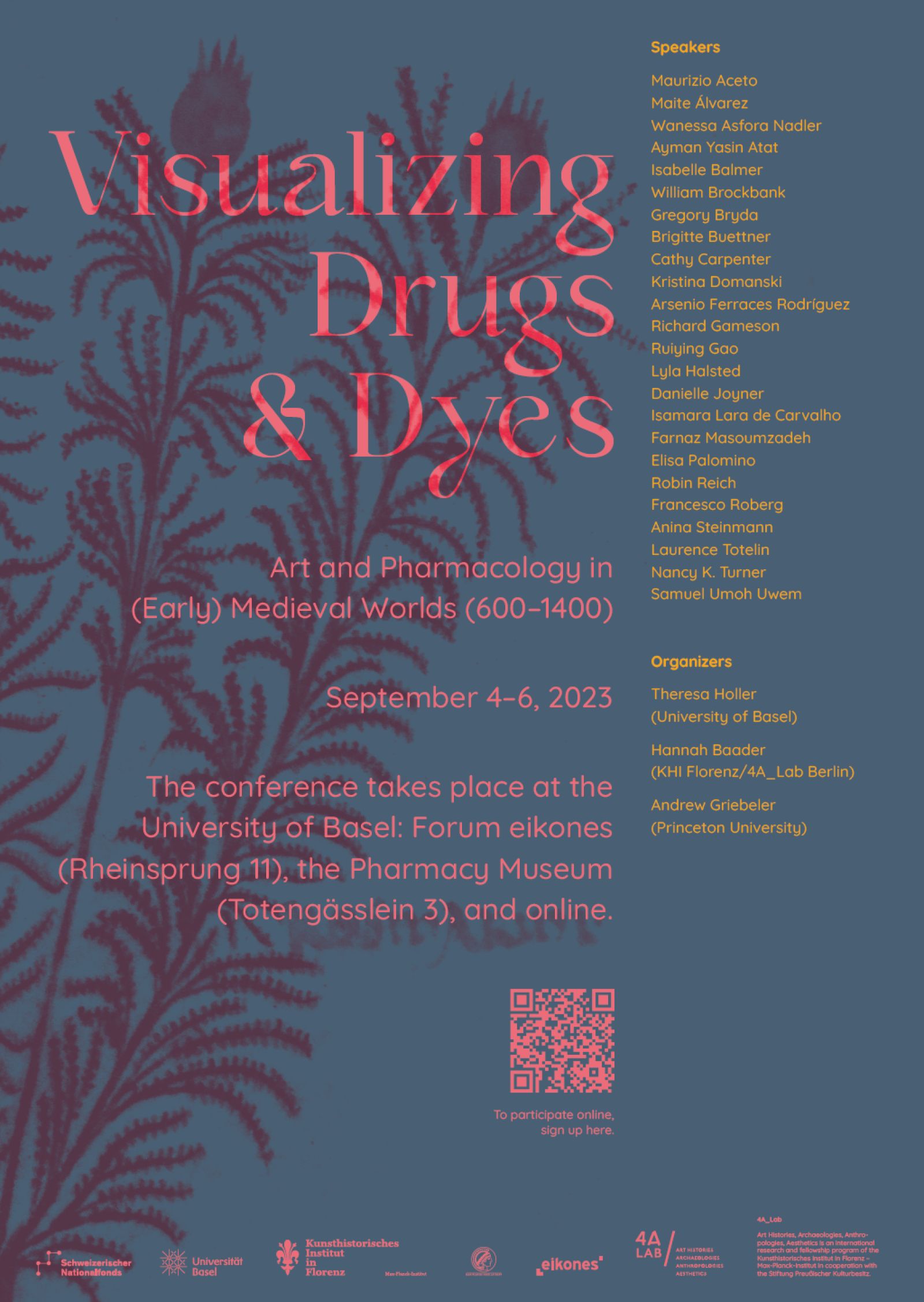Conference
Visualizing Drugs & Dyes. Art and Pharmacology in (Early) Medieval Worlds (600 - 1400)
Organized by Theresa Holler (University of Basel), Hannah Baader (KHI Florenz/4A_Lab Berlin), Andrew Griebeler (Princeton University)

Plants have long shaped the material practice and imagination of pharmacy. Far more than animals or minerals, plants and their products were central to medicine in premodern epistemologies. Over centuries, images and imaginings of vegetal materia medica played a profound role in human conceptions of and interactions with the natural world. In many ways, they continue to do so. Conversely, the therapeutic efficacy of plants and their products impacted broader visual and material cultures and practices. Thus, premodern pharmacological techniques interacted with the practices of image-making, artistic processes, and art.
Notwithstanding this close, underlying relationship between art and pharmacology in surviving medieval texts on healing and pharmacy produced between the 7th- 14th century, visualizations of medical substances have not yet sufficiently been the focus of art historical studies. Images of plants and their 'I pigments and dyes, invite further investigations into their epistemic status as well as their therapeutic, and mimetic capacities. What forms of knowledge do these images, materials, and substances provide? What audiences do they address? How can they be situated, between the practices and interests of scribes/painters, scholars, nuns and monks, physicians, apothecaries, gardeners, rhizotomes, and also readers - while taking into consideration the changing status of these human actors across society, gender, time, and space? What can such images, materials, and substances tell us about the interconnections between human and vegetal worlds? What role do colors, pigments and dyes, scent or the incorporation of prayers and charms play in the creation of images of healing? Moreover, how does medicinal, pharmacological or toxicological, plant-related knowledge circulate across vast (plant) geographies? The conference wants to connect the representations of simplicia such as ginger, plantain, pennyroyal, saffron, artemisia, liquorice, or strawberry from cities, rural communities, courts, and religious congregations in the Inda-Pacific, the so-called Levant, the Black Sea, the Mediterranean, and the Medieval West.
To participate online, please sign up here.
Program
Monday, September 4, 2023
Venue: University of Basel, eikones, Rheinsprung 11, 4051 Basel
09:00–09:15 Welcome & Introduction
Theresa Holler (University of Basel), Hannah Baader (KHI Florenz/4A_Lab Berlin) and Andrew Griebeler (Princeton University)
09:15–10:00 Richard Gameson (Durham University): The Colour of Plants
10:00–10:45 William Brockbank (Bern University): Wið eagena sare ond geswelle: Treating Afflictions of the Sensory Organs with the Old English Herbarium
10:45–11:00 Coffee Break
11:00–11:45 Laurence Totelin (Cardiff University): The Enslaved Rose? Visualising Roman Healing Roses and Those Who Worked with Them
11:45–12:30 Danielle Joyner (Lawrence University): Exploring the Tangled Roots of Glass Furnaces in Medieval Herbals
12:30–13:30 Light Lunch at eikones
Venue: University of Basel, Universitätsbibliothek, Schönbeinstrasse 18-20, 4056 Basel
14:00–16:00 Site visit with Monika Studer from the Manuscript Department (for speakers only)
Kristina Domanski (University of Basel): Heilende Ordnung – Heilung in der Unordnung (D III 14)
Venue: University of Basel, eikones, Rheinsprung 11, 4051 Basel
16:00–16:30 Coffee Break
16:30–17:15 Francesco Roberg (Wissenschaftliche Bibliothek der Stadt Trier/Stadtarchiv): Metrologie als Schlüssel zum Verständnis mittelalterlicher Rezepte
17:15–18:00 Robin Reich (Seattle University): The Many Lives of (Sal) Ammoniac in the Medieval Central Mediterranean
18:00–18:30 Brigitte Buettner (Smith College, Northampton, Massachusetts): Minerals as materia medica: Excavating the Visual Tradition (online)
18:30 Apéro Riche at eikones
Tuesday, September 5, 2023
Venue: Pharmacy Museum Basel University, Department of Pharmaceutical Sciences, Totengässlein 3, 4051 Basel
09:15–10:15 Site visit at the Pharmacy Museum with Elias Bloch (for speakers only)
10:15–10:45 Coffee Break
10:45–11:30 Maurizio Aceto (Università degli Studi del Piemonte Orientale): From Dioscorides to the Arab World: A Voyage into the Colourants Used in the Ancient Herbals
11:30–12:15 Ayman Yasin Atat (Technische Universität Braunschweig): Plants as Dyes in the Medieval Arabic Civilization; Ibn al-Bayṭār as a Case Study
12:15–13:00 Farnaz Masoumzadeh (Art University of Isfahan): Mimesis Approach in the Drug Illustrations of the Paris Kitāb al-Diryāq Based on Walter Benjamin’s Doctrine of the Similar
13:00–14:00 Light Lunch at the Pharmacy Museum
14:00–14:30 Ruiying Gao (Wake Forest University): Collecting Nature on Paper? An Early History of Materia Medical Images in China (online)
14:30–15:00 Lyla Halsted (Davidson College, Davidson, North Carolina): Therapeutic Arabic Scrolls: The Use of Saffron on Medieval Magic-Medicinal Amulets (online)
15:00–15:30 Wanessa Asfora Nadler (Universidade de Coimbra) & Isamara Lara de Carvalho (Universidade Federal de Minas Gerais): Madder: Arts, Crafts and Medical Literature at the Crossroads (online)
15:30–16:15 Isabelle Balmer (University of Basel) & Anina Steinmann (Stiftsarchiv St.Gallen): The Narrator Dyes. Analyzing Colour and Cure in Medieval Literature
16:15–16:45 Coffee Break
16:45–17:30 Arsenio Ferraces Rodríguez (Universidade da Coruña): Imaginario colectivo, tradición iconográfica e inercia de los editores: un nuevo nombre para la mandrágora en Isidoro de Sevilla (Etym. 17, 9, 30)
17:30–18:00 Gregory Bryda (Barnard College, Columbia University): A Mandrake Crucifix on the Wendish Borderlands of Styria (online)
Conference Dinner for Participants
Wednesday, September 6, 2023
Venue: Forum eikones, Rheinsprung 11, 4051 Basel
10:00–10:45 Samuel Umoh Uwem (University of KwaZulu-Natal): Indigenous Apothecary, Folkloric Claims and Musa paradisiaca in 11th-century Precolonial Nigeria
10:45–11:30 Elisa Palomino (Smithsonian Institution Arctic Studies Center): Use of Indigenous Arctic Plants as Dyes and Tannins in the Traditional Northern Fish Skin Processing
11:30–11:45 Coffee Break
11:45–12:30 Maite Álvarez & Cathy Carpenter (J. Paul Getty Museum): Woad in Medieval Spain: Exploring the Multifaceted Role of a Prized Colorant, Curative, Protective, and Decorative Material
12:30–13:30 Light Lunch at eikones
13:30–14:15 Closing Lecture
Nancy K. Turner (J. Paul Getty Museum): Pigments and Dyes, Vision and Healing: Finding materia medica in Manuscript Illumination
14:15–14:45 Round Table Discussion
After the conference, there will be the opportunity to see the Bauhin Herbarium together with Juriaan de Vos, Senior scientist & Curator of the Herbaria Basel and Botanical Garden at the Department of Environmental Sciences, Schönbeinstrasse 6 (15.30–16.30, limited number of people, by registration only: theresa.holler@unibas.ch).
04 – 06 September 2023
Venue
University of Basel: Forum eikones (Rheinsprung 11) & Pharmacy Museum (Totengässlein 3) & online
To participate online, please sign up here: https://unibas.zoom.us/meeting/register/u5cocuioqToqG9ya-6zA8_7LeLiEsT_MoaxO#/registration
Notice
This event will be documented photographically and/or recorded on video. Please let us know if you do not agree with the Kunsthistorisches Institut in Florenz using images in which you might be recognizable for event documentation and public relation purposes (e.g. social media).


